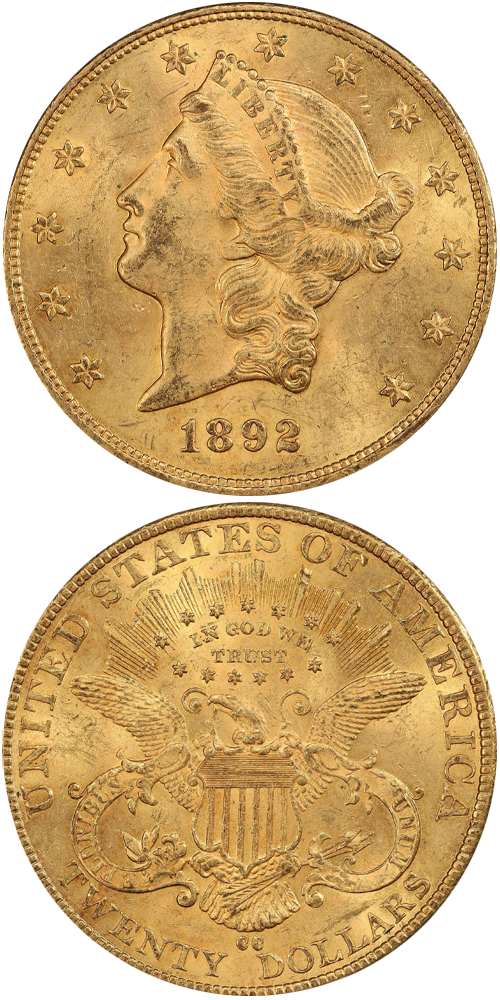1892-CC Liberty Head Double Eagle
Jeff Ambio: All known 1892-CC double eagles exhibit a small, well spaced date logotype that is fairly well centered in the field. The CC mintmark is small and compact with both Cs filled. The first C is basically centered over the space between the words TWENTY and DOLLARS, while the second C is over the serif of the letter D in DOLLARS.
Rusty Goe: On January 16, 1892, the Weekly Nevada State Journal published the entire text of a speech about the free coinage of silver given by the new Democratic U.S. senator from New York, David B. Hill. The topic weighed heavily on the minds of citizens of the Silver State. Many in that region believed that the restoration of a free coinage system, a bimetallic one, would revive its teetering mining industry and rescue the nation from the clutches of a tyrannical banking combine.
In his attempt to sort out the chaotic conditions prevailing at the time, Mint Director Edward O. Leech, in his 1892 annual report, said that "the preparation of monetary statistics" had "increased to such proportions as to seriously tax the capacity of [my] office to promptly supply the information called for..." "Owing very largely to the importance which coinage and currency questions have assumed in national legislation in recent years," his department had devoted countless hours to ""he compilation of a vast amount of statistical matter covering the product, use, and movement of the precious metals not only in this country, but in all countries."
Everyone at the Carson City Mint in 1892 knew that without the passage of a free coinage of silver law or the sustained call for silver dollars, their plant stood little chance of keeping its doors open -- at least for coining operations. Unfolding events that year had made it clear that the government's need for silver dollars had run its course. When Superintendent Wright died on the first of August, the mood turned dismal.
The coinage of gold had remained relatively steady in 1892, both under Wright's command and after Theodore Robert "Bob" Hofer took over. Just as had happened in 1891, however, half eagle and eagle output had taken precedence over that of the largest denomination. Coiner Colburn at Carson City had delivered 17,500 double eagles while Wright was still alive, and then added just 9,765 more after Hofer assumed the superintendency in the second half of the year, totaling 27,265.
The survival rate for 1892-CC $20 gold pieces, of four to five percent, is slightly higher than usual for the series, but still much lower than the disproportionately high eight percent figure from the miserly-mintage year of 1891.
Q. David Bowers: From the 1892-CC double eagle mintage, I estimate about 800 to 1,200 or so survive in circulated grades and 150 to 225 in Mint State, mostly MS-60 to MS-62 from repatriated coins brought in during the second half of the 20th century. In its time this coinage circulated extensively in the West and also was used in the export trade. The exportation seems to have taken place at least a few years after 1892, for most pieces were lightly worn at the time. In a by now familiar scenario, EF and AU coins abound, mostly from importations made in recent decades. Old-time collections were apt to include VF or EF coins, rarely an AU specimen.
The example to the left was sold by Stack's Bowers Galleries in the Fairmont Collection, CAG Set, where it realized $45,600.






